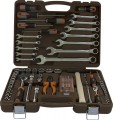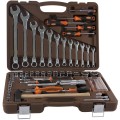Total number of items
The total number of core items included in the set.
In this case, the main items are all devices that are directly used during work: non-separable tools (traditional wrenches, hammers, pliers ...), elements of collapsible tools (for example, a ratchet for removable heads and 5 such heads will be considered 6 units) , as well as accessories (such as extensions or universal joints). Additional accessories — such as lights — may or may not be included in this count, depending on the manufacturer; however, there are usually few such accessories, and they do not fundamentally affect the total number of items.
The most modest modern tool kits include
up to 25 units. However, such kits are very popular — they are inexpensive and at the same time can be very versatile.
25 – 50 items is still quite a small number,
50 – 75 pcs can be called an average,
76 – 100 items are more than average, and the most extensive modern sets can include
100 – 150 items or even
more.
The general rules for choosing this parameter are obvious: a more extensive set, usually, is more multifunctional, but more expensive, weighs more and takes up more space. It is also worth bearing in mind that with a similar number of items, the specific assortment of these items in differ
...ent sets may be different; so when choosing, it is worth specifying not only the number of tools, but also their specific composition.Socket heads (6 points)
Number of
hex sockets included in the tool kit.
All end heads are accessories for a collapsible tool; during operation, they are mounted on a ratchet, wrench or other similar device. The head itself has the appearance of a characteristic “cap”, which, during operation, is put on a bolt, nut, etc. This design, among other things, allows you to work with parts located in recesses and some other hard-to-reach places that cannot be reached with open-ended, captive or split keys. And compared to a set of classic socket wrenches, the holder plus socket set takes up much less space, providing almost the same functionality.
As for the 6 faces, this type of socket head is the most famous and widespread, because. most modern nuts and bolts have this shape.
Universal joint
The number of
universal joints supplied with the tool kit.
First of all, we emphasize that this device should not be confused with wrenches that have a cardan. For more information about them, see paragraph "Gimbal" above; here we are not talking about an independent tool, but about an auxiliary device that is installed as an intermediate link between the main tool (for example, a crank, see above) and a working nozzle. Such a device allows you to position the axis of rotation of the tool at an angle relative to the axis of rotation of the nozzle with fasteners; this can be very convenient, in particular, when working in hard-to-reach places where there is not enough space for a classic "straight" tool.
Several universal joints, usually, are provided in sets with several options for the size of the landing square (see above) — one joint for each size.
Extension
The type of extension included with the tool kit.
Extensions refer to "intermediate" devices, if necessary, installed between the main tool (like a screwdriver handle, see above) and the working nozzle. As the name implies, they allow you to increase the length of the working part of the tool — for example, to get to hard-to-reach places. Here are the main options for such devices:
—
Hard. Rigid rod extension. It does not give such freedom of action and the ability to get to hard-to-reach places as flexible (see below), but it is considered more reliable, allows you to develop great efforts (often the same as when working without an extension cord) and even allows the use as an improvised lever. Some rigid extensions may also have a crank function (see above).
—
Flexible. An extension in the form of a flexible tube, usually made of a metal spiral. Such an extension, like a universal joint (see above), allows you to position the nozzle at an angle to the axis of rotation of the main tool — while the range of such angles is much wider (in some cases they can reach 180 °), and the long length and high mobility of the device are even more expands freedom of action. The disadvantage of flexible extensions is less suitability for work with greater efforts than the rigid ones described above.
— Rigid/flexible. This option is indicated for sets equipped with both types of
...extensions described above. This makes it possible to choose an option depending on the specific situation.
If there are several extensions of the same type in the kit, they, usually, differ in the size of the attachment (see "Landing square").Screwdriver
Number of classic
screwdrivers supplied in the kit. Note that some modern tool kits include
only screwdrivers, without any other fixtures or accessories.
Despite the proliferation of screwdriver handles with interchangeable bits (see above), traditional non-separable screwdrivers also remain popular nowadays. One of their advantages over collapsible counterparts is the convenience of working with different types of fasteners at the same time: keeping several separate screwdrivers with different sizes and types of tips on hand (for example, two flat and two cross-shaped ones) and taking a tool as needed is much more convenient than constantly changing bits on the screwdriver handle. Other advantages include strength, reliability, as well as matching the size of the handle to the size of the tip and the expected features of the work. So, screwdrivers for large fasteners are equipped with thick handles that allow you to develop a lot of effort; and with small tips, handles of small thickness are used, contributing to precision and accuracy.
As for the quantity, it is worth considering here: a larger number of screwdrivers gives more opportunities, however, the specific set of such tools (and opportunities) in different kits may be different. These details will not hurt to clarify before buying. Also note that it hardly makes sense to look for numerous screwdrivers for simple work — in suc
...h cases, a handle with bits may be more convenient.Slotted
Screwdrivers with flat tips, originally designed for a slot in the form of a slot. Note that such tips are quite versatile, they can be used with cross slots, and even with asterisks — the only thing is that in such cases it is impossible to apply great efforts due to the high probability of tool breakage.
Cross-recess
Screwdrivers with tips designed for cross slots. Note that flat screwdrivers also work with such slots; however, it is still better to use “native” tools — they distribute the load more evenly and allow you to apply great efforts without the risk of tearing the edges of the slot.
Voltage indicator
A screwdriver-shaped device consisting of a thin metal tip, a transparent dielectric handle, a high resistance resistor, a contact plate on the back of the handle, and a signal lamp. Designed to determine the phase wire, the presence of voltage in the network, diagnostics of automotive on-board networks.
Voltage indicators with batteries allow you to ring the electrical network for breaks. Advanced indicator screwdrivers are suitable for non-contact detection of wiring under a layer of finishing material and can be equipped with a light and sound informant.
Automotive indicators operate with a voltage of 6 to 24 V (less often — from 3 to 48 V) and can be equipped with a "crocodile". The rest are designed for voltages of 230 V and 400 V (sometimes up to 500 V).

